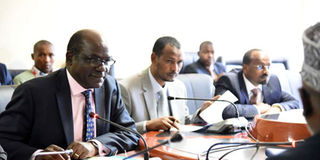Lawmakers vow to block IEBC bid to scrap constituencies

From left: IEBC commissioner Molu Boya, chairman Wafula Chebukati and commissioner Prof Yusuf Guliye at a past session before the National Assembly Justice, and Legal Affairs Committee. The commission is expected to review constituency boundaries in 2020. PHOTO | FILE | NATION MEDIA GROUP
What you need to know:
- The Independent Election and Boundaries Commission is set to review constituencies’ boundaries before 2022 elections.
- Isiolo South, Laisamis, North Horr, Saku, Siakago (now Mbeere North), Ndaragwa, Tetu, Murkurweini, Othaya and Kangema are some of the constituencies expected to be reviewed in 2020.
- For a constituency to maintain its status, the population must be greater or lesser than the quota by either 40 per cent for cities and sparsely populated areas and 30 per cent for other areas.
Legislators from Mt Kenya and North Eastern regions have vowed to block plans to scrap some of their constituencies that do not meet the population threshold required by the law.
The Independent Election and Boundaries Commission (IEBC) is set to review constituencies’ boundaries before 2022 elections.
Isiolo South, Laisamis, North Horr, Saku, Siakago (now Mbeere North), Ndaragwa, Tetu, Murkurweini, Othaya and Kangema are some of the constituencies expected to be reviewed in 2020 after the 2019 population census results are out.
They risk losing their status for not meeting the population quota as required under the law. During the 2010 review, the population threshold was 133,000 people. This figure could however change given the expected increase in population.
For a constituency to maintain its status, the population must be greater or lesser than the quota by either 40 per cent for cities and sparsely populated areas and 30 per cent for other areas.
REVIEW CONSTITUENCIES
The constituencies to be reviewed fail to meet the population threshold and hence could be merged to form new ones while others could be split.
The constituencies were however protected despite not meeting the required population quota during the first review.
Section 27 (4) of the Transitional and Consequential provisions states, "the boundaries commission shall ensure that the first review of constituencies undertaken in terms of this Constitution shall not result in the loss of a constituency existing on the effective date.”
This resulted in the protection of the 27 constituencies that were below the population quota. But during the the second review. in 2020, this caveat won't apply.
Mbeere North MP Muriuki Njagagua said the protected semi-arid constituency already had a population of over 100,000 and it would be wrong to scrap it.
80,000 REGISTERED VOTERS
He has expressed optimism that his constituency will have the 80,000 registered voters before the review. He at the same time said the region was protected owing that it is largely inhabited by Mbeere community, which is a minority in Embu county.
"I believe we are still protected and will fight for that protection as a minority. You cannot just kill minority constituencies. We will fight it tooth and nail," he said.
Isiolo South MP Abdi Koropu Tepo threatened to take the battle to court if the electoral body abolishes his constituency noting that IEBC should instead consider splitting it due to its vastness
“ I will legally fight IEBC's move or root for constitutional amendment so that the constituencies will be retained. I take days to go round my constituency unlike other MPs who use hours to do the same," said the MP.
He argued that area has been marginalised for over 50 years and it would be unfair to scrap it off since as it would lead to further relegation.
SEMI-ARID AREAS
Speaking to journalists in Marsabit town earlier this month, Saku MP Ali Dido Rasso said that if constituencies in semi-arid areas are scrapped, the ripple effect will be felt by the counties as development would be slow."
In Nyeri, half of the constituencies could be reviewed due to low population. According to Kenya National Bureau of Statistics, Tetu Constituency has a projected population of 95,519, Mukurweini 102,363 and Othaya 106,561.
According to the Tetu MP Gichuhi Mwangi, the population has increased considerably since the last election and it may not be affected by the review.
“I will not support a decision to scrap my constituency because my people will be poorly represented in Parliament,” he said.




